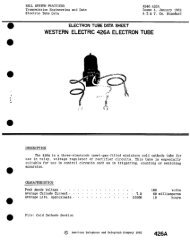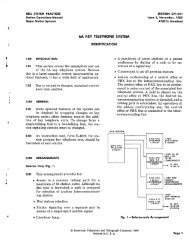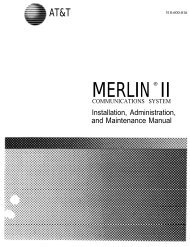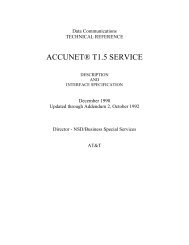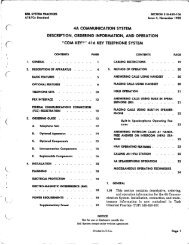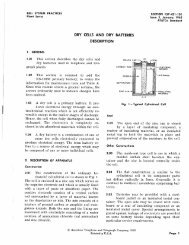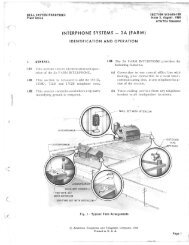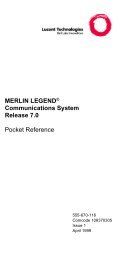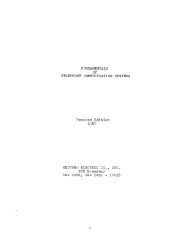COMMON LANGUAGE LOCATION IDENTIFICATION (CLLI) CODE ...
COMMON LANGUAGE LOCATION IDENTIFICATION (CLLI) CODE ...
COMMON LANGUAGE LOCATION IDENTIFICATION (CLLI) CODE ...
You also want an ePaper? Increase the reach of your titles
YUMPU automatically turns print PDFs into web optimized ePapers that Google loves.
alpha characters or 2-numeric characters and occu<br />
pies character positions 7 and 8 of the <strong>CLLI</strong> code format.<br />
Note: Building code cannot be a combina<br />
tion of alpha and numeric characters, eg, H5 or<br />
5H is not permitted.<br />
5.05 Building codes are assigned to the place and<br />
state in which they are geographically located.<br />
When a building is outside the boundaries of all identified<br />
places, it should be assigned to the nearest<br />
place within the state.<br />
5.06 The alpha character "X" in character position<br />
7 is reserved for identification of Independent<br />
Telephone Company owned buildings. To identify<br />
Independent Telephone Company buildings, use the<br />
alpha character "X" in position 7 and any other alpha<br />
character in position 8 of the <strong>CLLI</strong> code format.<br />
Example:<br />
NAME<br />
Independent Telephone<br />
Company Building<br />
BUILDING PLACE, STATE, AND<br />
<strong>CODE</strong> BUILDING <strong>CODE</strong><br />
XA CITYSTXA<br />
5.07 Where a building code is required and the<br />
building location is unknown (as in long range<br />
planning), a hyphen (-) is used in character position<br />
8 of the <strong>CLLI</strong> code format. Any alpha character is<br />
used in character position 7.<br />
Example:<br />
Building (location<br />
unknown)<br />
Building-Independent<br />
telephone company<br />
(location unknown)<br />
BUILDING PLACE, STATE, AND<br />
<strong>CODE</strong> BUILDING <strong>CODE</strong><br />
B- CITYSTB-<br />
X- CITYSTX-<br />
5.08 When a company elects to code each building<br />
in a complex (defined in paragraph 5.02) using<br />
a separate building code for each building in the complex,<br />
entities (subdivisions) common to two (or more)<br />
of the buildings must be assigned to only one of the<br />
building codes.<br />
. Guideline: When the equipment and facilities in two<br />
ISS 5, SECTION 795-100-100<br />
(or more) buildings share a common frame, the<br />
equipment, facilities, and frame must be identified as<br />
being in only one of the buildings. It is not the intent<br />
of the <strong>CLLI</strong> code to subdivide a building into parts<br />
according to floor, ownership, function, etc, and assign<br />
each part a separate building code. Refer to Part<br />
10, Figure 2a.<br />
5.09 When telephone equipment and/or personnel<br />
are temporarily located in a trailer which<br />
must be identified, the trailer may be identified and<br />
coded as a separate building, or it may be included as<br />
part of an existing building with which it is associat<br />
ed.<br />
6. ENTITY (FORMERLY BUILDING SUBDIVISION)<br />
(CHARACTER POSITIONS 9 THROUGH 11)<br />
6.01 An Entity (formerly called a Building Subdi-<br />
vision) is defined as any unit of equipment,<br />
work group, person, or job function which is directly<br />
related to message and/or data switching and termination.<br />
Entities are assignable to two broad categories:<br />
Switching and Nonswitching.<br />
Note: This element of the <strong>CLLI</strong> code was<br />
identified previously as "Building subdivision"<br />
code, and included three components identified<br />
as Traffic Units, Plant Units, and Administrative<br />
Units. To simplify the <strong>CLLI</strong> coding process<br />
and to provide additional code flexibility, a code<br />
grouping concept has been implemented. All<br />
existing Traffic, Plant, and Administrative<br />
Codes have been grouped into two categories:<br />
Switching Entities and Nonswitching Entities,<br />
and the code element has been renamed "Entity."<br />
No existing <strong>CLLI</strong> codes are changed by the<br />
introduction of this concept.<br />
6.02 Entities are uniquely identified by the Entity<br />
Code suffixed to the Place, State, and Building<br />
Codes (character positions 1 through 8). Entity codes<br />
are associated with the place, state, and building in<br />
which they are physically located.<br />
6.03 Entity Codes are developed, assigned, and<br />
managed by operating company <strong>CLLI</strong> coordinators,<br />
using the guidelines suggested by this section.<br />
6.04 Entity Code Formats: Entity code is a 3-<br />
character alphanumeric field which occupies<br />
Page 7







